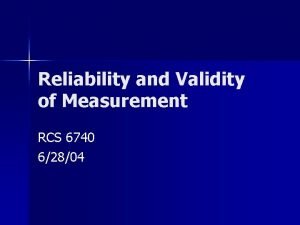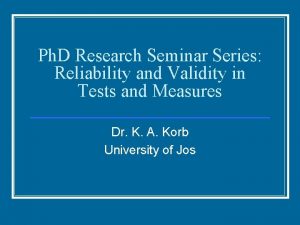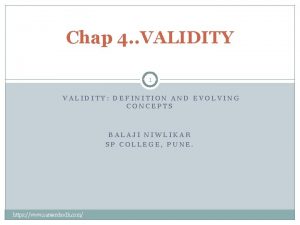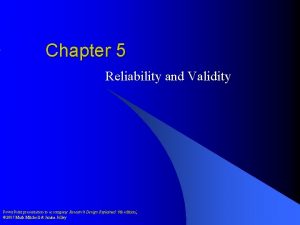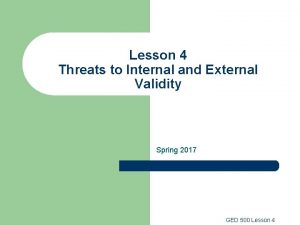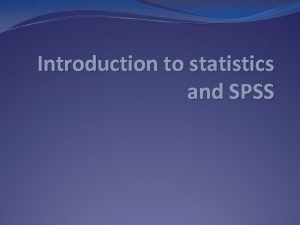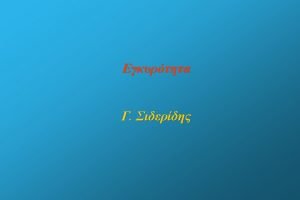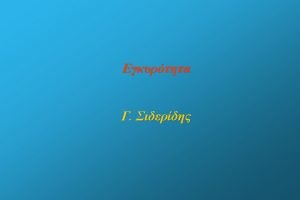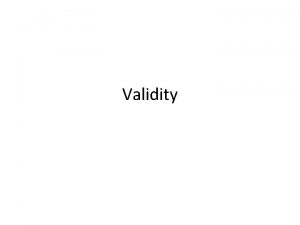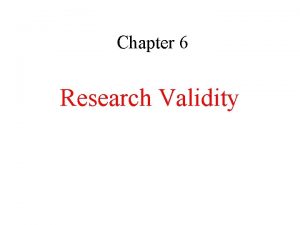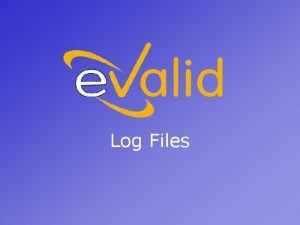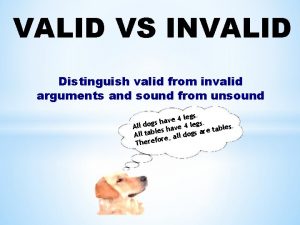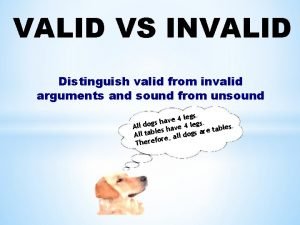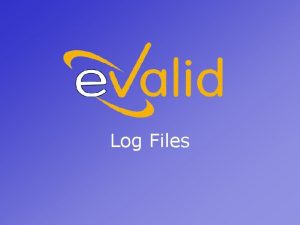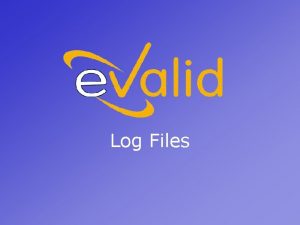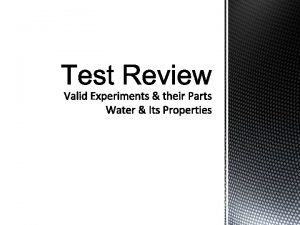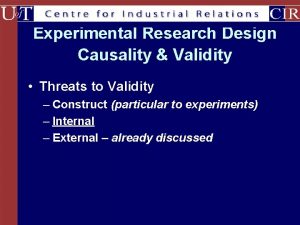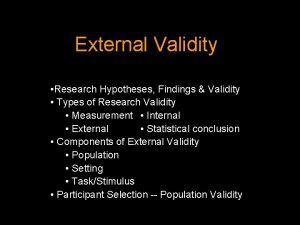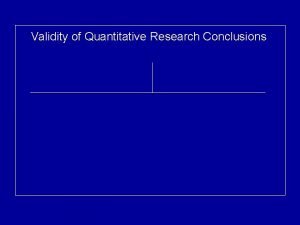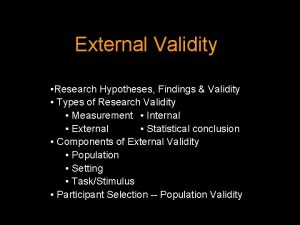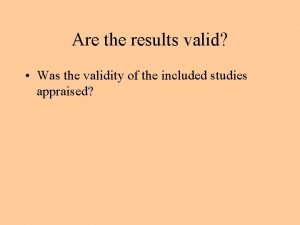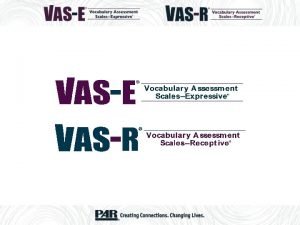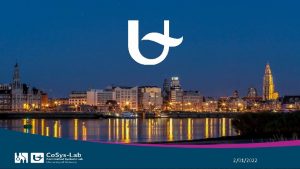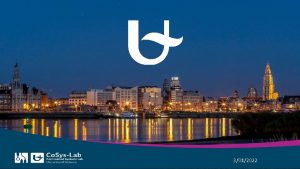Validity When is research valid Validity Over the











































- Slides: 43

Validity When is research valid?

Validity • Over the history of research we have adopted rules to establish validity of research. • In quantitative research this is done in part by controlling the quality of the tools used to gather data. • In qualitative research you are the data gathering tool. • How do you account for yourself in the pursuit of validity?

Positionality • I see what I am disposed to see. • When I see something it means that I do not see other things. (figure/ground)


The Influence of Positionality These things are particularly true for qualitative research because there are fewer controls on validity than quantitative. • Research design • Data gathering • Analysis

With Positionality in Mind: Observation Systematic Data Collection Approach

Characteristics of Observation • Prolonged engagement in a setting or social situation in order to: – describe objects, events, and interactions – become oriented to the situation so that the context is appreciated and understood – be able to detect and account for distortions that might be in the data – rise above your own preconceptions – build trust

Characteristics of Observation • Clearly expressed, self-conscious notations of how observing is done – Positionality (Biases) – Researcher impact – Ethics

Characteristics of Observation • Clearly expressed, self-conscious notations of how observing is done – Positionality (Biases) – Researcher impact – Ethics

Observation Researcher

Observation Researcher When does researcher proximity affect the behavior of those observed? When does observation become participant observation?

Characteristics of Observation • Clearly expressed, self-conscious notations of how observing is done – Positionality (Biases) – Researcher impact • Recording observations • Prolonged engagement – Ethics

Characteristics of Observation • Clearly expressed, self-conscious notations of how observing is done – Positionality (Biases) – Researcher impact • Recording observations • Prolonged engagement – Ethics • DO NO HARM!

Characteristics of Observation • Methodical and tactical improvisation in order to develop a full understanding of the setting of interest

Characteristics of Observation • Imparting attention in ways that are in some sense standardized – Observing something specific • Driven by the problem statement • Driven by prior observation – Observing from a model • Using a pre-existing coding structure

A brief side trip (once again) to theoretical frameworks

Study Progress You decide on the meaning of what you found. Some problem exists that you think is worth studying. You write a purpose statement to say exactly what you want to study. You find out what others already know about this problem. You report on what you found. You design some way to gather and analyze evidence.

Problems • The problem with this model is that there is no way to predict if this work is a personal adventure or if it will help all of us understand the issue under investigation better. • Is this an opinion or is it substantiated reasoning? • The way to solve this is to use a theoretical framework.

You decide on the meaning of what you found. Some problem exists that you think is worth studying. You write a purpose statement to say exactly what you want to study. You find out what others already know about this problem. Theoretical Framework You report on what you found. Theoretical Framework You design some way to gather and analyze evidence.

You decide on the meaning of what you found. Some problem exists that you think is worth studying. You write a purpose statement to say exactly what you want to study. You find out what others already know about this problem. Theoretical Framework You report on what you found. Theoretical Framework You design some way to gather and analyze evidence.

A theoretical framework helps you get into and out of your study based on some model accepted by the research community. Often, a theoretical framework will not appear until the point at which you are designing data gathering. Always, theoretical frameworks will not make sense until you have an established purpose statement.

What does this look like in real life? • I want to know if kids learn better if they collaborate on projects. • I start looking at the literature around problem-based learning, cooperative learning, direct instruction, service learning, active learning, generative learning, studentcentered pedagogy, and anything else that comes to mind. • I meet with my study advisor and we decide: The purpose of this study is to examine the impact of active learning in secondary chemistry classrooms on student understanding of Nature of Science concepts.

And now … • My literature review focuses on the nature of science and how it is taught in secondary classrooms in general, and specifically in chemistry classrooms. • In the process of looking at this I find: Lederman, N. G. , Abd‐El‐Khalick, F. , Bell, R. L. , & Schwartz, R. S. (2002). Views of nature of science questionnaire: Toward valid and meaningful assessment of learners’ conceptions of nature of science. Journal of Research in Science Teaching, 39(6), 497 -521.

Next • This scaffold with which to examine No. S understanding does three things: – First, it helps me to decide how to structure an intervention that is likely to improve No. S understanding (Active Learning) – Then it helps me figure out how to assess the impact of the intervention – And last, it helps me make judgments about my results (how did the results match Lederman et al. ’s model? )

You decide on the meaning of what you found. Some problem exists that you think is worth studying. You write a purpose statement to say exactly what you want to study. You find out what others already know about this problem. No. S Framework You report on what you found. No. S Framework You design some way to gather and analyze evidence.

Theoretical Framework • I did not know this framework existed until my focused purpose statement lead me to it. • There is no prescribed order in which the pieces of the puzzle must me put together.

Back to: Characteristics of Observation • Imparting attention in ways that is in some sense standardized – Observing something specific • Driven by the problem statement • Driven by prior observation – Observing from a model • Using a pre-existing coding structure

Observing from a Model The model tells me what to observe Classroom observation


Every act involving a choice or decision in teaching may be analyzed on three levels. Technical: What exactly is going on? What is observed? What actions and behaviors are involved? What techniques are being used? This is a technical description of what you see. Interpretive: What meaning did it have for whom? How is what is happening being experienced by individuals or groups? This is a description of the impact of what you see on the people involved. Critical: Is this the best choice and for whom? Why is it good or not good? Is it ethical? Is it just? Does it have merit, value? By whose criteria or philosophy? This is a description of the value (ethics) of what is being observed. These reflections are the basis for decisions you make as a teacher. Effective reflection— especially critical—is a key to understanding your own philosophy of education. The model tells you how to interpret what you observe.

Observing from a Model • The model – Provides a frame for gathering data – Provides a structure for analyzing the data

How to do Observations • Recording observations – Context – Action – Narrative – Memoing

Context • Describe the environment – You may have to adjust the description afterward – Make a drawing – Annotate the drawing during the observation – Take a picture – Gather anything you may need for later analysis

How to Observe • Writing neutral narratives – Keeping them neutral – Including enough detail – Using a focus

Memos • Do not lose process thoughts while observing • Memo types – Theoretical notes • Constructivism requires a student centered curriculum – Methodological notes • I should talk to Johnny as example of a low achiever – Analytic memos • Bobby and Sally both wore expensive shoes

Narrative Memos


O. C. Observer Comment

Observation Strategies • Good observation notes read like the text of a stage play: blocking and dialog • If you have a good enough recorder, consider recording – Describe action without dialog – More focus on writing field notes

Observation Strategies • If you cannot take notes while observing, write them immediately afterwards • Even if you can take notes while observing, review notes immediately after you write them • Taking notes – Hand written – Typing (Word or Excel documents)

Excel format/cells/alignment/wrapped

Excel Time stamps PC clt-shift-colon Mac command-shift-colon

Creswell’s Data Collection Circle Locating site or individual Coding Gaining access and making rapport Storing data Purposefully sampling Resolving field issues Recording information Collecting data
 Criterion validity
Criterion validity Convergent validity
Convergent validity What is content validity
What is content validity Construct validity def
Construct validity def Reliability and validity in research ppt
Reliability and validity in research ppt What is external validity
What is external validity What is external validity in research
What is external validity in research Over the mountain over the plains
Over the mountain over the plains Siach reciting the word over and over
Siach reciting the word over and over Explain how to handing over and taking over the watch
Explain how to handing over and taking over the watch Hát kết hợp bộ gõ cơ thể
Hát kết hợp bộ gõ cơ thể Frameset trong html5
Frameset trong html5 Bổ thể
Bổ thể Tỉ lệ cơ thể trẻ em
Tỉ lệ cơ thể trẻ em Voi kéo gỗ như thế nào
Voi kéo gỗ như thế nào Tư thế worm breton
Tư thế worm breton Hát lên người ơi alleluia
Hát lên người ơi alleluia Các môn thể thao bắt đầu bằng tiếng chạy
Các môn thể thao bắt đầu bằng tiếng chạy Thế nào là hệ số cao nhất
Thế nào là hệ số cao nhất Các châu lục và đại dương trên thế giới
Các châu lục và đại dương trên thế giới Công thức tính thế năng
Công thức tính thế năng Trời xanh đây là của chúng ta thể thơ
Trời xanh đây là của chúng ta thể thơ Mật thư anh em như thể tay chân
Mật thư anh em như thể tay chân 101012 bằng
101012 bằng độ dài liên kết
độ dài liên kết Các châu lục và đại dương trên thế giới
Các châu lục và đại dương trên thế giới Thể thơ truyền thống
Thể thơ truyền thống Quá trình desamine hóa có thể tạo ra
Quá trình desamine hóa có thể tạo ra Một số thể thơ truyền thống
Một số thể thơ truyền thống Bàn tay mà dây bẩn
Bàn tay mà dây bẩn Vẽ hình chiếu vuông góc của vật thể sau
Vẽ hình chiếu vuông góc của vật thể sau Biện pháp chống mỏi cơ
Biện pháp chống mỏi cơ đặc điểm cơ thể của người tối cổ
đặc điểm cơ thể của người tối cổ V cc cc
V cc cc Vẽ hình chiếu đứng bằng cạnh của vật thể
Vẽ hình chiếu đứng bằng cạnh của vật thể Tia chieu sa te
Tia chieu sa te Thẻ vin
Thẻ vin đại từ thay thế
đại từ thay thế điện thế nghỉ
điện thế nghỉ Tư thế ngồi viết
Tư thế ngồi viết Diễn thế sinh thái là
Diễn thế sinh thái là Các loại đột biến cấu trúc nhiễm sắc thể
Các loại đột biến cấu trúc nhiễm sắc thể Số nguyên là gì
Số nguyên là gì Tư thế ngồi viết
Tư thế ngồi viết

